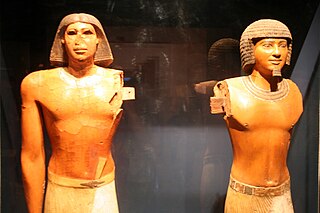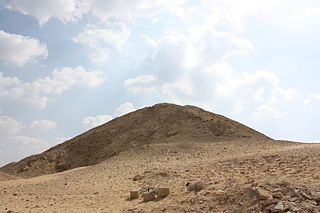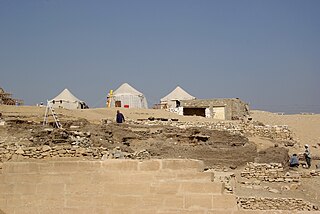
Saqqara, also spelled Sakkara or Saccara in English, is an Egyptian village in the markaz (county) of Badrashin in the Giza Governorate, that contains ancient burial grounds of Egyptian royalty, serving as the necropolis for the ancient Egyptian capital, Memphis. Saqqara contains numerous pyramids, including the Pyramid of Djoser, sometimes referred to as the Step Pyramid, and a number of mastaba tombs. Located some 30 km (19 mi) south of modern-day Cairo, Saqqara covers an area of around 7 by 1.5 km.
Teti, less commonly known as Othoes, sometimes also Tata, Atat, or Athath in outdated sources, was the first king of the Sixth Dynasty of Egypt. He was buried at Saqqara. The exact length of his reign has been destroyed on the Turin King List but is believed to have been about 12 years.

Djedkare Isesi was a pharaoh, the eighth and penultimate ruler of the Fifth Dynasty of Egypt in the late 25th century to mid-24th century BC, during the Old Kingdom. Djedkare succeeded Menkauhor Kaiu and was in turn succeeded by Unas. His relationship to both of these pharaohs remain uncertain, although it is often conjectured that Unas was Djedkare's son, owing to the smooth transition between the two.

Ptahhotep, sometimes known as Ptahhotep I or Ptahhotpe, was an ancient Egyptian vizier during the late 25th century BC and early 24th century BC Fifth Dynasty of Egypt. He is credited with authoring The Maxims of Ptahhotep, an early piece of Egyptian "wisdom literature" meant to instruct young men in appropriate behavior.

Khnumhotep and Niankhkhnum were two male ancient Egyptian royal servants. The men shared the title of Overseer of the Manicurists in the Palace of King Nyuserre Ini, sixth pharaoh of the Fifth Dynasty, reigning during the second half of the 25th century BC. They were buried together at Saqqara and are listed as "royal confidants" in their joint tomb. They are notable for their unusual depiction in Egyptian records, often interpreted as the first recorded same-sex couple.

The pyramid of Teti is a smooth-sided pyramid situated in the pyramid field at Saqqara in Egypt. It is the second known pyramid containing pyramid texts. Excavations have revealed a satellite pyramid, two pyramids of queens accompanied by cult structures, and a funerary temple. The pyramid was opened by Gaston Maspero in 1882 and the complex explored during several campaigns ranging from 1907 to 1965. It was originally called Teti's Places Are Enduring. The preservation above ground is very poor, and it now resembles a small hill. Below ground the chambers and corridors are very well preserved.

Ptahshepses was the vizier and son-in-law of pharaoh Nyuserre Ini during the Fifth Dynasty. As such he was one of the most distinguished members of the royal court. Ptahshepses' mastaba complex in Abusir is considered by many to be the most extensive and architecturally unique non-royal tomb of the Old Kingdom.
Khuit II was a wife of King Teti, the first pharaoh of the Sixth Dynasty of Egypt.

Mereruka served during the Sixth Dynasty of Egypt as one of Egypt's most powerful officials at a time when the influence of local state noblemen was increasing in wealth and power. Mereruka held numerous titles along with that of Vizier, which made him the most powerful person in Egypt after the king himself. Among the other official positions that Mereruka held were "Director of all the king's works," "Governor of the palace," "Chief lector-priest," "Overseer of the royal record scribes," and "Inspector of the priests attached to the pyramid of Teti." He was married to Seshseshet Waatetkhethor, daughter of King Teti. His mother was named Nedjetempet and he possibly had a brother named Ihy, though this may be the same individual as Ihyemsaf, his grandson.
Kagemni I was an ancient Egyptian who lived from the end of the 3rd Dynasty to the beginning of the 4th Dynasty. He was a vizier to both Pharaoh Huni and Pharaoh Sneferu.

Rashepses was a vizier from the Fifth Dynasty of Egypt. Rashepses was vizier under Djedkare Isesi. A letter directed to Rashepses has been preserved. This decree is inscribed in his tomb in Saqqara. As vizier he was one of the most important Ancient Egyptian officials. In his tomb are many titles recorded. It seems that he was first overseer of the scribes of the royal documents, overseer of the two granaries and overseer of all royal works. These are all very important titles, making him an influential official at the royal court. At the final stage of his career he became vizier. The vizier title is only preserved in two letters that are copied on the decoration of the tomb. It seems that most of his tomb was finished and after all that, he was promoted.

Maia was the wet nurse of the ancient Egyptian pharaoh Tutankhamun in the 14th century BC. Her rock-cut tomb was discovered in the Saqqara necropolis in 1996.
Neferseshemre also called Seshi was a vizier from the early or middle part of the reign of King Teti of the Sixth Dynasty of Egypt.
Meryteti served as vizier of Pepi I during the Sixth Dynasty of Egypt. He was the son of the vizier Mereruka. His mother was the royal daughter Seshseshet Waatetkhethor, daughter of Teti. He was thus a nephew of the king Pepi I Meryre.
This page list topics related to ancient Egypt.

Shemay was an ancient Egyptian official and later vizier toward the end of the 8th Dynasty during the First Intermediate Period, mainly known for being the beneficiary of most of the Coptos Decrees. His career has been interpreted as a glaring sign of the extreme weakness of the central power, forced to bestow great privileges to maintain the loyalty of powerful local governors. Shemay is buried in a mudbrick mastaba just south of Coptos.

The Mastaba of Hesy-re is an ancient Egyptian tomb complex in the great necropolis of Saqqara in Egypt. It is the final resting place of the high official Hesy-re, who served in office during the Third Dynasty under King Djoser (Netjerikhet). His large mastaba is renowned for its well-preserved wall paintings and relief panels made from imported Lebanese cedar, which are today considered masterpieces of Old Kingdom wood carving. The mastaba itself is the earliest example of a painted tomb from the Old Kingdom and the only known example from the Third Dynasty. The tomb was excavated by the Egyptologists Auguste Mariette and James Edward Quibell.
Mastaba S3504 is a large mastaba tomb located in the Saqqara necropolis in Lower Egypt. It was built during the reign of the ancient Egyptian Pharaoh Djet, in the First Dynasty, shortly after 3000 BC. It is one of the largest mastabas from this dynasty. The building was excavated in 1953 by Walter Bryan Emery.

Mehu was an Ancient Egyptian vizier who lived in the Sixth Dynasty, around 2300 BC. The office of the vizier was the most important one at the royal court. Mehu is mainly known from his monumental mastaba at Saqqara, not far away from the Pyramid of Unas.
Rawer was an ancient Egyptian official of the Sixth Dynasty of Egypt. His main title was that of a vizier, making him to one of the highest officials at the royal court. Rawer is so far only known from his rather modest mastaba found at Saqqara, close to the pyramid of king Teti. Rawer had several titles, including overseer of Upper Egypt, but also royal sealer and beloved of god.



 Vizier Kagemni, in the left column, a list of sacrificial offerings, fat cattle, poultry from the three courts, desert game and fruits from vast waters
Vizier Kagemni, in the left column, a list of sacrificial offerings, fat cattle, poultry from the three courts, desert game and fruits from vast waters




















